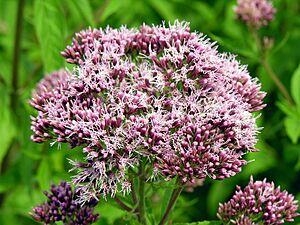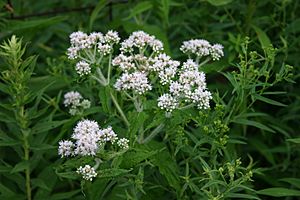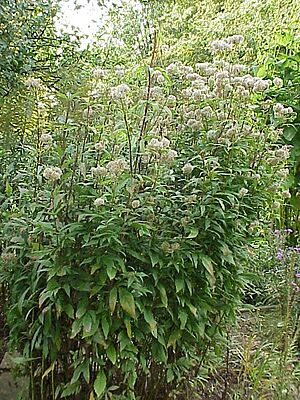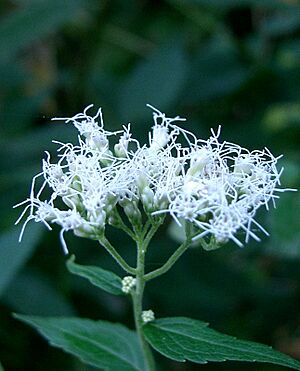Eupatorium facts for kids
Quick facts for kids Eupatorium |
|
|---|---|
 |
|
| Eupatorium cannabinum | |
| Scientific classification |
|
| Kingdom: | Plantae |
| Clade: | Tracheophytes |
| Clade: | Angiosperms |
| Clade: | Eudicots |
| Clade: | Asterids |
| Order: | Asterales |
| Family: | Asteraceae |
| Supertribe: | Helianthodae |
| Tribe: | Eupatorieae |
| Genus: | Eupatorium L. 1753 not Bubani 1899 (Rosaceae) |
| Synonyms | |
|
|
Eupatorium is a group (called a genus by scientists) of flowering plants that belong to the daisy family (officially known as Asteraceae). Scientists think there are between 36 and 60 different kinds (or species) of Eupatorium plants.
Most Eupatorium plants are herbaceous perennials. This means they are soft-stemmed plants (not woody like trees) that live for several years. They usually die back in winter and grow again in spring. They can grow quite tall, from about 0.5–3 m (1.6–9.8 ft). Some types are shrubs, which are small, woody plants.
These plants originally come from areas with mild weather (called temperate regions) in the Northern Hemisphere (the top half of the Earth). In North America, people often call them bonesets, thoroughworts, or snakeroots. The name Eupatorium actually comes from a king named Mithridates Eupator. He was the king of a place called Pontus a long time ago.
Contents
How Scientists Classify Eupatorium
Figuring out exactly which plants belong to the Eupatorium group has been a bit tricky for scientists. At one point, they thought there might be as many as 800 different kinds! But over time, many of these plants have been moved into other groups (genera). Some of these other groups include Ageratina, Chromolaena, Condylidium, Conoclinium, Critonia, Cronquistianthus, Eutrochium (which includes the Joe-Pye weeds), Fleischmannia, Flyriella, Hebeclinium, Koanophyllon, Mikania, and Tamaulipa.
Scientists are still studying how all these plants in the larger Eupatorieae tribe (a bigger family group) are related. So, the way these plants are organized might change again in the future as they learn more. What seems pretty clear now is that there's a main group of about 42 species of Eupatorium. These usually have white flowers and are found in North America, Europe, and Asia, but not in South America. This group is closely related to the Joe-Pye weeds (Eutrochium).
How People Use Eupatorium Plants
Some Eupatorium plants are grown in gardens just because they look nice. These are called ornamental plants, and they are especially popular in Asia. Some well-known garden plants that used to be called Eupatorium are now in different groups, like Bartlettina and Conoclinium.
Like many plants, Eupatorium can sometimes get sick from plant diseases, such as the Tobacco leaf curl virus. Also, the leaves of these plants are food for some types of caterpillars (the young stage of moths and butterflies), like the larvae of Orthonama obstipata (The Gem).
Traditional Medicine and Names
Many of the common names for Eupatorium plants, like "boneset" and "thoroughwort," come from how one particular type, Eupatorium perfoliatum, was used in traditional herbal medicine.
Where Did the Name "Boneset" Come From?
You might think "boneset" was used to help heal broken bones, but that's not quite right. The name probably came about because this herb was used to treat an illness called dengue fever. Dengue fever was sometimes called "breakbone fever" because it caused so much pain, it felt like your bones were breaking. So, "boneset" was meant to help with that "breakbone" feeling.
What About "Thoroughwort"?
The name "thoroughwort" also comes from Eupatorium perfoliatum. It describes how the leaves grow on the stem. The leaves are "perfoliate," which means the stem looks like it goes right through the leaf. "Thorough" is an old way of saying "through," like in the word "thoroughfare" (a road that goes through a place).
Important Health Warnings
People have used boneset in folk medicine for things like helping the body get rid of too much uric acid. Too much uric acid can cause a painful joint problem called gout.
However, it's very important to be careful with boneset. These plants can be poisonous to people and farm animals. They contain toxic substances that can harm the liver. Using boneset can cause side effects like muscle shakes, feeling weak, and constipation (trouble pooping). Taking too much can be extremely dangerous and even deadly. It is not safe to use these plants as medicine without expert medical advice.
Some Types of Eupatorium
Here are some of the different species (kinds) of Eupatorium plants found around the world.

Plants from North America
- Eupatorium album L. – Also known as white thoroughwort.
- Eupatorium altissimum L. – Called tall thoroughwort.
- Eupatorium anomalum Nash – Known as Florida thoroughwort. This one is an apomictic hybrid (meaning it reproduces without fertilization) from Eupatorium mohrii and Eupatorium rotundifolium.
- Eupatorium capillifolium (Lamarck) Small – Commonly called dog-fennel.
- Eupatorium compositifolium Walter – Known as Yankeeweed.
- Eupatorium godfreyanum Cronquist – An apomictic hybrid from Eupatorium rotundifolium and Eupatorium sessilifolium.
- Eupatorium hyssopifolium L. – Called hyssop-leaved thoroughwort.
- Eupatorium lancifolium (Torrey & A.Gray) Small – Known as lance-leaved thoroughwort.
- Eupatorium leptophyllum DC. – Called false fennel.
- Eupatorium leucolepis (DC.) Torrey & A.Gray – Known as justiceweed.
- Eupatorium linearifolium Walter – Also known as Eupatorium cuneifolium.
- Eupatorium maritimum E.E.Schill. – An apomictic hybrid from Eupatorium mohrii and Eupatorium serotinum.
- Eupatorium mikanioides Chapman – Called semaphore thoroughwort.
- Eupatorium mohrii Greene – Known as Mohr's thoroughwort.
- Eupatorium novae-angliae (Fernald) V.I.Sullivan ex A.Haines & Sorrie – An apomictic hybrid from Eupatorium paludicola and Eupatorium perfoliatum.
- Eupatorium paludicola E.E.Schill. & LeBlond – Called swamp thoroughwort. Until 2007, it was considered part of Eupatorium leucolepis.
- Eupatorium perfoliatum L. – This is the common boneset.
- Eupatorium petaloideum Britton – Known as showy white thoroughwort. Scientists often think it's part of Eupatorium album.
- Eupatorium pilosum Walter – Called rough boneset. Often considered part of Eupatorium rotundifolium.
- Eupatorium resinosum Torrey ex DC. – Known as pine barren boneset.
- Eupatorium rotundifolium L. – Called round-leaved thoroughwort.
- Eupatorium semiserratum DC. – Known as smallflower thoroughwort.
- Eupatorium serotinum L. – Called late boneset or late thoroughwort.
- Eupatorium sessilifolium L. – Known as upland boneset.
- Eupatorium sullivaniae E.E.Schill. – An apomictic hybrid from Eupatorium album and Eupatorium lancifolium.
Plants from Europe
- Eupatorium cannabinum L. – Known as hemp-agrimony.
Plants from Asia
- Eupatorium amabile Kitam.
- Eupatorium benguetense C.Robinson
- Eupatorium camiguinense Merr.
- Eupatorium chinense L.
- Eupatorium formosanum Hayata
- Eupatorium fortunei Turcz. – Known as fujibakama or pei lan.
- Eupatorium japonicum Thunb. (Often included in E. chinense)
- Eupatorium leonardii Ferreras & E.E.Lamont
- Eupatorium lindleyanum DC.
- Eupatorium luchuense Nakai
- Eupatorium makinoi T.Kawahara & T.Yahara (Sometimes seen as part of E. chinense)
- Eupatorium nodiflorum DC.
- Eupatorium quaternum DC.
- Eupatorium sambucifolium Elmer
- Eupatorium shimadai Kitam.
- Eupatorium squamosum D.Don
- Eupatorium tashiroi Hayata
- Eupatorium toppingianum Elmer
- Eupatorium variabile Makino
- Eupatorium yakushimaense Masam. & Kitam
Plants That Used to Be Eupatorium
Science is always learning new things! Many plants that scientists once thought were Eupatorium have now been moved to different groups (genera). This happens as scientists get better at understanding how plants are related. Here are some examples:
- Eupatorium adamantium Gardner is now in the genus Koanophyllon.
- Eupatorium amygdalinum is now in Ayapana.
- Eupatorium ayapana (also called aya-pana or water hemp) is now Ayapana triplinervis.
- Eupatorium bracteatum Gardn. is now in Stomatanthes (specifically S. pernambucensis).
- Eupatorium coelestinum (mistflower) is now in Conoclinium.
- Eupatorium collinum is now Chromolaena collina.
- Eupatorium itatiayense Hieron. is now in Symphyopappus.
- Eupatorium gayanum is now Aristeguietia gayana.
- Eupatorium laevigatum DC. is now in Chromolaena.
- Eupatorium ligustrinum is now Ageratina ligustrina.
- Eupatorium maculatum (Joe-Pye weed) is now Eutrochium maculatum.
- Eupatorium maximiliani Schrad. ex DC. is now in Chromolaena.
- Eupatorium megalophyllum is now Bartlettina sordida.
- Eupatorium officinale is now in Mikania.
- Eupatorium pacificum is now in Ageratina.
- Eupatorium purpureum is now Eutrochium purpureum.
- Eupatorium pyrifolium DC. is now in Steyermarkina.
- Eupatorium rufescens P.W.Lund. ex DC. is now in Kaunia.
- Eupatorium rugosum is now Ageratina altissima.
- Eupatorium sordidum is now Bartlettina sordida.
- Eupatorium squalidum DC. is now in Chromolaena.
- Eupatorium urticaefolium is now in Ageratina (it's another name for A. altissima).
- Eupatorium vauthierianum DC. is now Heterocondylus alatus.



